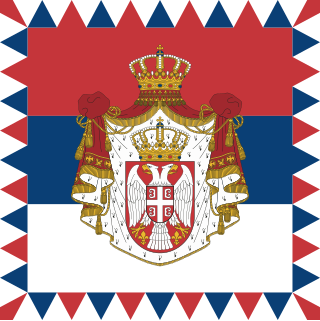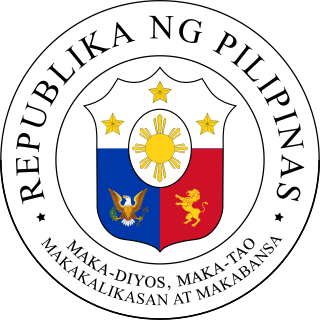Related Research Articles
A head of state is the public persona who officially embodies a state in its unity and legitimacy. Depending on the country's form of government and separation of powers, the head of state may be a ceremonial figurehead or concurrently the head of government and more.

Article Two of the United States Constitution establishes the executive branch of the federal government, which carries out and enforces federal laws. Article Two vests the power of the executive branch in the office of the president of the United States, lays out the procedures for electing and removing the president, and establishes the president's powers and responsibilities.

The Twenty-fifth Amendment to the United States Constitution deals with presidential succession and disability.

A commander-in-chief or supreme commander is the person who exercises supreme command and control over an armed force or a military branch. As a technical term, it refers to military competencies that reside in a country's executive leadership, a head of state, head of government, or other designated government official.

The prime minister of Pakistan is the head of government of the Islamic Republic of Pakistan. Executive authority is vested in the prime minister and his chosen cabinet, despite the president of Pakistan serving as the nominal head of executive. The prime minister is often the leader of the party or the coalition with a majority in the lower house of the Parliament of Pakistan, the National Assembly where he serves as Leader of the House. Prime minister holds office by virtue of their ability to command the confidence of the National Assembly. The prime minister is designated as the "Chief Executive of the Islamic Republic".

The president of the Socialist Republic of Vietnam is the head of state of Vietnam, elected by the Vietnam National Assembly from delegates of the National Assembly. Since Vietnam is a single-party state, the president is generally considered to hold the second highest position in the political system, formally after the general secretary of the Communist Party of Vietnam. In addition, the president appoints the head of government, the prime minister. As head of state, the President represents Vietnam both domestically and internationally, and maintains the regular and coordinated operation and stability of the national government and safeguards the independence and territorial integrity of the country.

The Government of Ireland is the cabinet that exercises executive authority in Ireland.

The president of Serbia, officially styled as the President of the Republic is the head of state of Serbia.
The Department of the Taoiseach is the government department of the Taoiseach, the title in Ireland for the head of government. It is based in Government Buildings, the headquarters of the Government of Ireland, on Merrion Street in Dublin.

The Cabinet of the Philippines consists of the heads of the largest part of the executive branch of the national government of the Philippines. Currently, it includes the secretaries of 22 executive departments and the heads of other several other minor agencies and offices that are subordinate to the president of the Philippines.

The Government of Singapore is defined by the Constitution of the Republic of Singapore to comprise of the President and the Executive. Executive authority of Singapore is vested in the President but exercised on the advice of the Cabinet led by the Prime Minister. The President, acting as the Head of State, may only act in their discretion in appointing the Prime Minister, acting as the Head of Government; as well as withholding consent for the dissolution of Parliament; along with performing key checks on the Government in addition to the ceremonial duties of the Head of State inherited from the Westminster system. The Cabinet, consisting of the Prime Minister and ministers appointed by the President on the Prime Minister's advice, is responsible for heading the Executive through ministries and other statutory boards. At the end of the term or at any time during the term, once the President has consented to a request made by the Prime Minister to dissolve Parliament, Parliamentary General Elections are held to elect members of Parliament for a new term. The President, in their discretion, then appoints a Prime Minister who is a member of Parliament representing any political party or coalition of political parties who in their judgement is likely to command the confidence of the majority of the members of Parliament. The Prime Minister then forms the Government and, along with the Cabinet, sets the general direction and control of the Government for the next term.

The Commission on Appointments is a constitutional body which confirms or rejects certain political appointments made by the President of the Philippines. The current commission was created by the 1987 Constitution.
Commonwealth is a term used by four of the 50 states of the United States in their full official state names. "Commonwealth" is a traditional English term used to describe a political community as having been founded for the common good. The four states – Kentucky, Massachusetts, Pennsylvania, and Virginia – are all in the Eastern United States, and prior to the formation of the United States in 1776 were British colonial possessions. As such, they share a strong influence of English common law in some of their laws and institutions. However, the "commonwealth" appellation has no legal or political significance, and it does not make "commonwealth" states any different from other U.S. states.
The Cabinet of Malaysia is the executive branch of the Government of Malaysia. Led by the Prime Minister, the cabinet is a council of ministers who are accountable collectively to the Parliament. According to the Article 43 of the Federal Constitution, members of the Cabinet can only be selected from members of either houses of Parliament. Formally, the Yang di-Pertuan Agong appoints all Ministers on the advice of the Prime Minister. The constitution is amended by repealing the Clause (8) of Article 43, enabling a person who is a member of State Legislative Assembly to continue to serve even while serving as a minister or deputy minister in the cabinet. Ministers other than the Prime Minister shall hold office during the pleasure of the Yang di-Pertuan Agong, unless the appointment of any Minister shall have been revoked by the Yang di-Pertuan Agong on the advice of the Prime Minister but any Minister may resign from office. In practice, the Yang di-Pertuan Agong is obliged to follow the advice of the Prime Minister on the appointment and dismissal of ministers.

The Mississippi secretary of state is an officer of Mississippi originally established under the Article IV, §14 of Mississippi Constitution of 1817, and was reestablished under Article V, §133 of the Mississippi Constitution of 1890.

Proposition 8 of 1911 was an amendment of the Constitution of California that introduced, for the first time, the recall of public officials. This allows the governor, state senators and assemblymen, and other elected officials to be removed from office early by a public vote. It was approved by voters in a referendum held as part of a special election on 10 October. On the same day voters approved two other major political reforms, Proposition 4, which granted women the vote, and Proposition 7, which introduced the initiative and the optional referendum.
Part Nine of the Constitution of Albania is the ninth of eighteen parts. Titled The Courts, it consists of 22 articles including the Article 144 which was repealed in 2016. Together with Part Eight (Constitutional Court), and Part Ten (The Office of the Prosecutor) underwent radical changes in 2016 during the so-called Justice Reform, which were the efforts of lawmakers to fight corruption, organized crime, nepotism in the justice system.

Chapter II of the Constitution of Australia establishes the executive branch of the Government of Australia. It provides for the exercise of executive power by the Governor-General advised by a Federal Executive Council.

The executive branch of the government of Puerto Rico is responsible for executing the laws of Puerto Rico, as well as causing them to be executed. Article IV of the Constitution of Puerto Rico vests the executive power on the Governor—whom by its nature forms the executive branch.
Part Ten of the Constitution of Albania is the tenth of eighteen parts. Titled The Office of the Prosecutor, it consists of 13 articles. Together with Part Eight (Constitutional Court), and Part Nine (The Courts) underwent radical changes in 2016 during the so-called Justice Reform, which were the efforts of lawmakers to fight corruption, organized crime, nepotism in the justice system.